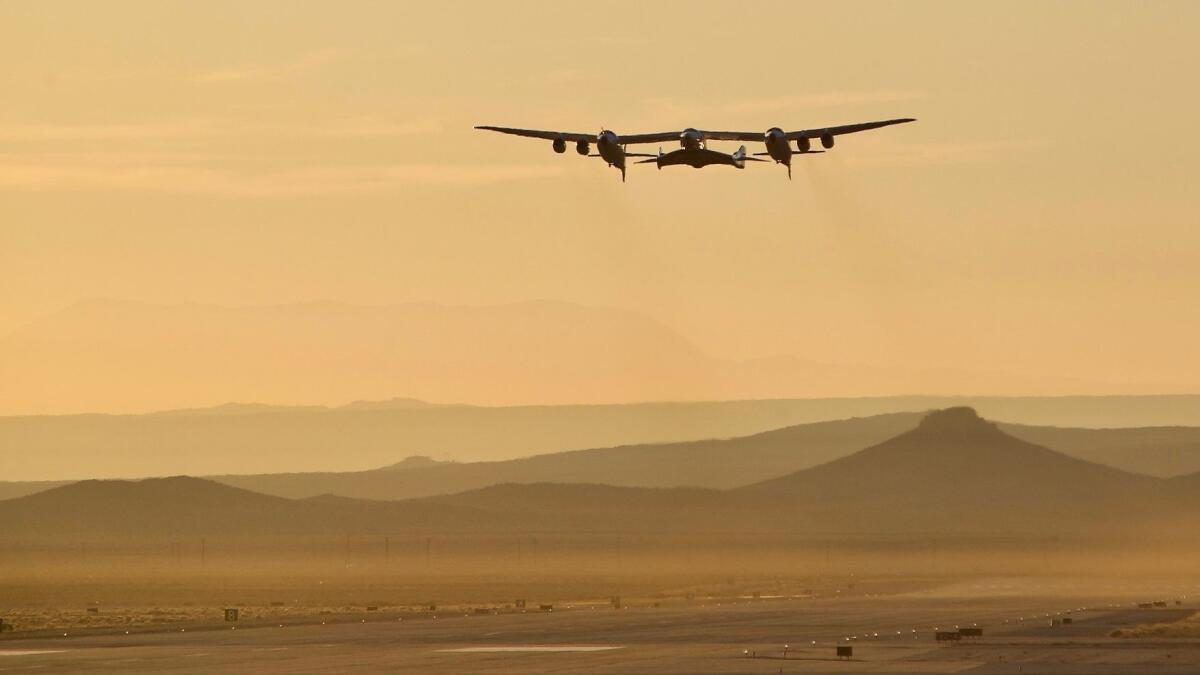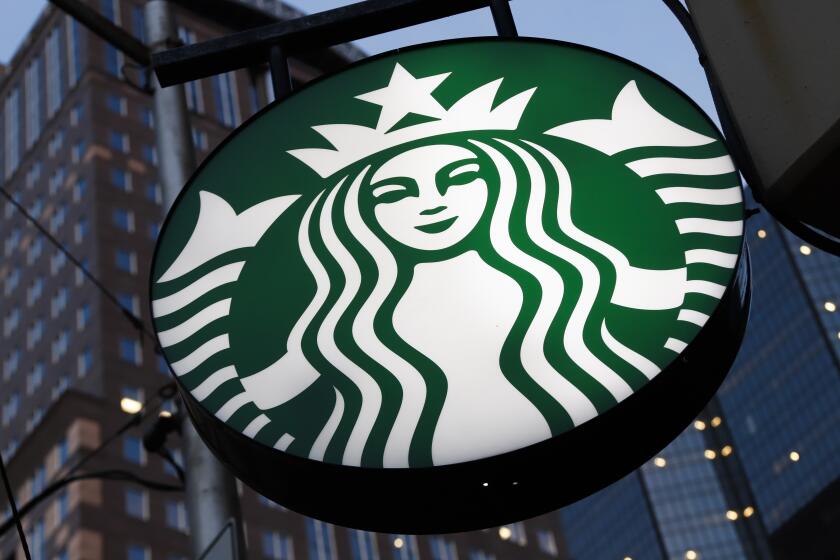Cutbacks at Stratolaunch, Virgin Galactic show the space industry is entering a second stage
Even space projects backed by billionaires are not immune to Earth-bound realities.
Almost two weeks ago, after the death of founder Paul Allen, Stratolaunch Systems Corp. said it would cease development of a rocket engine and two planned satellite-launching rockets as well as a rocket-powered plane that could take a crew to space. The Seattle venture described its retrenchment, which reportedly includes dozens of layoffs, as “streamlining operations” and said it would allow the company to focus on conducting a first test flight of its massive satellite-launching aircraft.
Also this month, Elon Musk’s SpaceX and British billionaire Richard Branson’s Virgin Galactic announced layoffs as Virgin Galactic reshapes its workforce to prepare for commercial operations of its space tourism business and Hawthorne-based SpaceX pivots toward development of its satellite-internet project and Mars rocket and spaceship.
Analysts and commercial space insiders say the cutbacks are coincidental and don’t indicate a major industry downturn. In the case of Stratolaunch, it shows the potential fragility of relying on the vision of a single wealthy benefactor, as do several of the companies, including SpaceX, Virgin Galactic and Blue Origin. Allen died just three months ago from complications of non-Hodgkin’s lymphoma.
Stratolaunch is a company that was “based on passion,” said Greg Autry, director of the Southern California Commercial Spaceflight Initiative at USC. “It appears his heirs don’t share that passion.”
Companies such as SpaceX and Virgin Galactic, on the other hand, are entering new phases of their businesses. Virgin Galactic is transitioning away from major work in research and development, while SpaceX is now focusing on expensive new endeavors at a time when launch demand for large geostationary satellites is slowing.
“Both are at a point where they’re seeking to demonstrate that they can succeed in new markets,” said Carissa Christensen, chief executive of analytic consulting firm Bryce Space and Technology. “There’s an explanation that this is simply the normal path of business. It may also be a matter of one or both of those companies trying to more carefully manage their cash and resources.”

Founded in 2011 by Allen, a Microsoft co-founder, Stratolaunch originally billed itself as bringing “airport-like operations to the launch of commercial and government payloads and, eventually, human missions.”
The idea was to use an air-launch platform — in this case, an aircraft with conjoined-twin fuselages connected by a wing longer than an American football field and powered by six Boeing 747 engines. That plane would hoist a rocket carrying a satellite to a higher altitude before releasing it to blast into space.
That approach would allow companies like Stratolaunch to avoid potential bottlenecks at launchpads and get more flexibility to reach various orbits, industry experts said. The plane is being tested in Mojave, Calif., and built by Scaled Composites, which is owned by Northrop Grumman Corp. In 2016, Stratolaunch said it would use Pegasus XL rockets, now from Northrop Grumman, which have been used in another air-launch platform — the Stargazer L-1011.
Those plans were ambitious enough. Then Stratolaunch upped them.
Last year, the company said it would develop more launch vehicles for its massive plane: a medium-class vehicle that could launch payloads weighing up to about 7,500 pounds, a more powerful variant with three engine cores to lift heavier satellites, and a fully reusable space plane to carry cargo and, eventually, crew. The company also started developing a liquid rocket engine that could power those launch vehicles.
In announcing on Jan. 18 that it was scaling back, Stratolaunch said it would focus on conducting a test launch of a Pegasus XL rocket from the aircraft. “We are immensely proud of what we have accomplished and look forward to first flight in 2019,” the company said in its statement.
Tech-news publication Geekwire reported that more than 50 people were being laid off. Stratolaunch declined to comment beyond its prepared statement, but an industry official said that the company had about 80 total employees before the layoffs and that about 22 people will be left by April.
Not surprisingly, Allen’s death led to speculation about the company’s future. “It’s never been a market-driven company,” said Chad Anderson, chief executive of Space Angels, a global network for early-stage space industry investors. “It’s been a passion project of a really wealthy individual. And now that individual is gone.”
The space industry, meanwhile, has grown beyond just billionaire-funded firms. “They have seeded the industry, and the market has now come in and taken over,” Anderson said. “There’s not four companies. There’s 400.”
A total of $18 billion has been invested worldwide in 412 space companies since 2009, nearly $3 billion in the last year alone, according to Space Angels. Investors range from corporations and wealthy individuals to venture capitalists and retail investors, Anderson said.
“That speaks to the evolution and maturation of the market, as well, in a really short period of time,” he said.
Palo Alto-based Swarm Technologies is typical of the start-ups that have sprung up to build or launch small communications and imaging satellites. This month the company said it raised $25 million in a Series A round led by SpaceX investor Craft Ventures and EarthLink founder Sky Dayton. The 11-employee company plans to launch a satellite constellation composed of 150 spacecraft, each as small as a grilled-cheese sandwich, to provide low-cost internet access for “internet of things” devices, such as sensors.
The tiny satellites maneuver like “a dart in space” — their mass is offset in such a way that allows natural forces to stabilize the spacecraft without using thrusters. The company compares their movement to that of a sailboat, as opposed to a motorboat. The network could be operational by 2020, said company Chief Executive Sara Spangelo.
But the “move fast and break things” ethic of Silicon Valley got the company in trouble last year. Swarm agreed to pay a $900,000 fine to the Federal Communications Commission for launching four of its tiny satellites without the agency’s permission. The FCC had denied Swarm’s application because it said the satellites were too small to be tracked, which could increase the risk of in-orbit collisions.
Spangelo said the company has worked with the FCC on that issue since last spring and worked with government and commercial space-tracking systems to consistently track the seven satellites it already has in orbit. The company has also hired an internal officer to make sure it is in compliance with all U.S. and international regulations, she said.
“I think we’ve learned that we’re committed to compliance,” she said of the FCC fine.
A market shakeup, especially for launch companies, could still be coming in the next two to three years, said Autry of USC. But what he sees happening now is companies like Virgin Galactic and SpaceX reaching new stages of their business development.
Just over two weeks ago, Mojave-based Virgin Galactic and sister firm Spaceship Co. laid off about 40 people, less than 5% of the workforce at those two companies, a company spokesperson said. Most of the affected employees were based in Mojave. The layoffs were first reported by New Mexico publication NMPolitics.net. The company said in a statement that the move was made “to position our organization for the drive to commercial operations following our successful recent spaceflight, and make room for new skill sets that we need to bring in over the course of this year.”
Virgin Galactic plans to offer brief suborbital flights in its space plane for as much as $250,000 per ticket. The company reached suborbital space for the first time without paying customers during a December test flight. The company is aiming to conduct its next test in February.
Both Virgin Galactic and SpaceX, which laid off about 10% of its more than 6,000-employee workforce earlier this month, are facing pivotal moments this year, said Mike French, senior vice president for commercial space at Bryce Space and Technology. Virgin Galactic is inching closer to flying paying tourists to space, while SpaceX is scheduled to ferry NASA astronauts to the International Space Station for the first time this summer.
The Musk-led company is facing an additional looming deadline with its planned Starlink satellite-internet project. The FCC has mandated that SpaceX begin operating at least half of the satellites in its initial constellation by March 29, 2024, or it cannot add any additional satellites. The company has said it plans to launch its first batch of satellites before the end of next year, and already sent up two test ones last year.
“This is really the year to see which companies can close their business cases and make money,” Christensen said.
Twitter: @smasunaga
More to Read
Inside the business of entertainment
The Wide Shot brings you news, analysis and insights on everything from streaming wars to production — and what it all means for the future.
You may occasionally receive promotional content from the Los Angeles Times.











